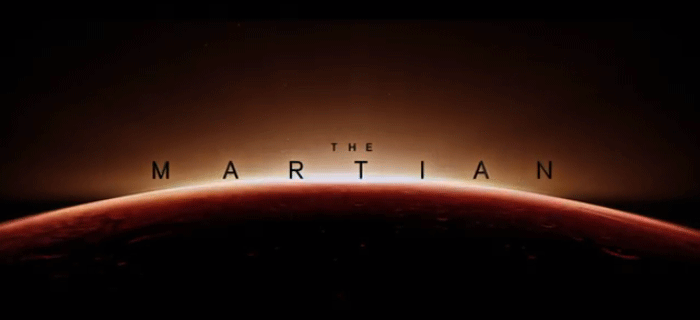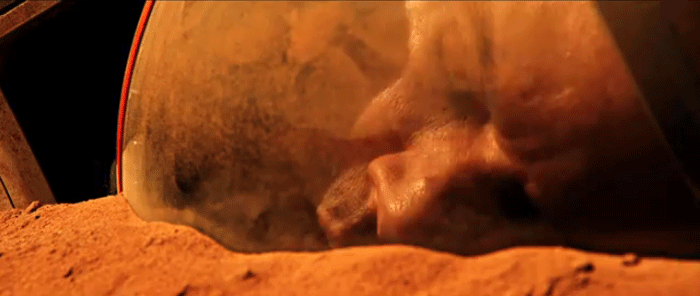.


In the trailer for The Martian, a defiant, Mars-bound Matt Damon vows “to science the shit out of this.” He then proceeds to farm greens on red Martian soil and recycle his sweat into water. Where most sci-fi films are heavier on the fi than the sci, this one looks like it might maintain a balance. And reports indicate same: Ridley Scott brought on NASA’s Director of Planetary Science, Jim Green, as a consultant, and Andy Weir’s source material was painstakingly researched. Still, it never hurts to double check the facts.
So that’s what we did with some help from Dr. Mikki Osterloo, an expert on Martian geology at the University of Colorado’s Laboratory for Atmospheric and Space Physics.

The Landscape
Dr. Osterloo gave Scott’s landscape an A+. “The way they laid out the terrain looks really believable,” she told Inverse. “Mars is probably going to have rocky outcrops, like they show — rugged, with a lot of gusts and sands. And I think they got the colors pretty accurate.”
Damon’s Mark Watley appears to land in the relatively flat, equatorial region of Mars, which makes the most sense for a solar-powered mission, says Osterloo. (It might not be the best choice in terms of access to water, but more on that later.)
The Storm
Osterloo isn’t as sure about the huge sandstorm that brings down Watley’s mission. She admits that atmospheric research isn’t her realm of expertise, but she questions what sort of “low-atmopsheric processes” could turn sand grains into projectiles. “I generally don’t think of Mars as having hurricane-force sorts of winds, especially where they landed — equatorial, so they can be solar powered,” she says. “I don’t know if that’s accurate or not. I would say maybe not a common occurrence.”

Space Farming
“I am the greatest botanist on this planet,” Watley announces, overlooking his mini-field of potatoes grown in Martian soil. It’s pretty impressive, says Osterloo, considering that the planet’s soil is probably too acidic and devoid of organics to be useful for farming.
If we’re ever going to pull off long-term missions to Mars, we’re going to need to figure out how to produce our own food. Watley’s makeshift greenhouse and rustic Mars garden is, at the moment, a bit far fetched, but NASA has just proven that space farming isn’t impossible: Just a few weeks ago, astronauts onboard the ISS had their first taste of space-grown lettuce, grown using NASA’s Veggie system, a series of soil “pillows” embedded with seeds.
Water recovery
There isn’t much a potato farmer can do with Mars’ meager supply of polar ice, especially when he’s stuck at the equator, so Watley resorts to recycling his sweat and urine into useable H2O using a painfully slow water reclaimer. While there is evidence for liquid water flows in Martian mountain ranges, says Osterloo, you’d have to dig deep to get to it, and the briny liquid would still have to be desalinated before it could be used for crops. There is research going into sublimating and precipitation water in the Martian atmosphere, she says, but it isn’t clear it’ll be enough to support human life and farms.
In principle, Watley’s device isn’t that different from the Water Recovery System at the ISS, where all water is recycled. As one NASA astronaut put it, “Yesterday’s coffee turns into tomorrow’s coffee.”
Habitats
In his interview with NASA’s Jet Propulsion Lab, Dr. Green discusses bringing Scott out to the Johnson Space Center to look at the habitats that the space agency has been developing. Scott no doubt took inspiration from NASA’s HERA, or Human Exploration Research Analog — a two-story self-contained habitat complete with living quarters, hygiene module, and simulated airlock — in which astronauts carry out 14-day (soon to be 60-day) simulations of deep-space missions. Judging by the trailer, Scott’s Hab gets the airlock down — as well as the feeling of utter isolation (how bleak is that handwritten calendar?).
Space Suits
Watley’s space suit, a surprisingly sleek-looking thing, was inspired by NASA’s Z-2 and eXploration prototypes, designed to be flexible and comfortable as well as protective against the red planet’s harsh climate and dusty wind. According to Scott, Watley’s suit is heavy enough to make up for the lower gravitational pull on Mars.
Mental Health
The best part of The Martian will be the joy of rooting for Matt Damon, Hollywood’s favorite stranded space hero, as he attempts to keep his own spirits high with dorky science quips (“In your face, Neil Armstrong!”) and fleeting contacts with Earth. But it isn’t really clear whether even a trained astronaut would survive, physically or psychologically, through four years of complete isolation. Right now, NASA’s in the middle of running its longest space simulation ever — an 8-month project that involves locking up six individuals in a 1,200-square-foot dome halfway up Hawaii’s Mauna Loa — to investigate the psychological and social effects of long-term space travel.
.


Trailer-Video hier: https://www.youtube.com/watch?v=Ue4PCI0NamI
Quelle: NVERSE
4778 Views
